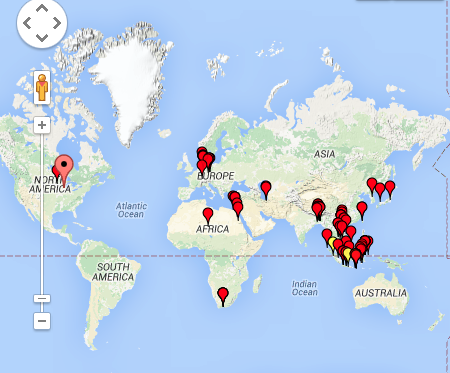Section 2. Prevention
| Site: | Extension Foundation Online Campus |
| Course: | Avian Influenza Biosecurity for Backyard Flock Owners |
| Book: | Section 2. Prevention |
| Printed by: | Guest user |
| Date: | Tuesday, December 2, 2025, 5:46 PM |
Description
- Prevention
- Biosecurity
- Isolation
- Traffic Control
- Sanitation
- Decontamination
- Vaccination
- Registration
- Fairs, Shows, and Exhibits
- Surveillance and Monitoring
Table of contents
- Prevention
- What is Biosecurity?
- Biosecurity Measures
- Isolation
- Traffic Control
- Keep It Clean
- Sanitation I: Waste Management
- Sanitation II: Carcass Disposal
- Decontamination
- When to Clean and Disinfect Equipment
- Equipment Decontamination Steps
- Vaccination
- Registration
- Exhibits, Fairs, and Shows
- Surveillance and Monitoring
- Global Surveillance and Monitoring
- Keeping Your Birds Healthy Video from the USDA
Prevention
By the end of this section you should be able to
- List at least three reasons for being prepared and
- Describe biosecurity and surveillance measures that can stop the spread of disease.
Prevention is the key to protecting your birds from AI and other diseases. Birds lost to disease can lead to financial and emotional losses. Use biosecurity precautions to reduce the risk of your birds contracting and spreading disease among your flocks.
This short U.S. Department of Agriculture (USDA) video is an introduction to the basics of biosecurity.
USDA APHIS "Healthy Bird" Video
What is Biosecurity?
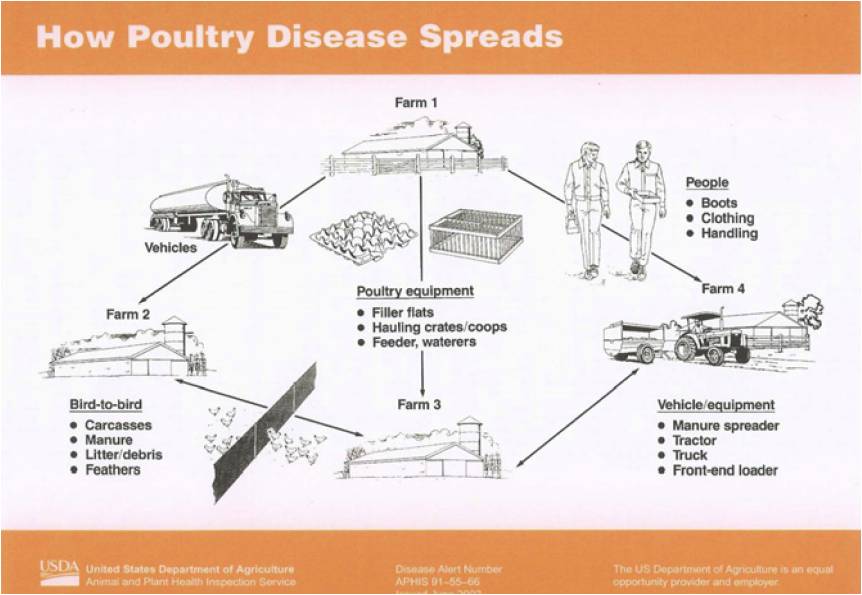
Biosecurity Measures
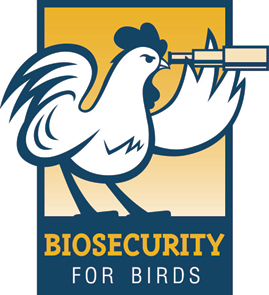 Good biosecurity is essential for preventing disease in your birds. To be effective, your plan should incorporate these three major elements:8
Good biosecurity is essential for preventing disease in your birds. To be effective, your plan should incorporate these three major elements:8- Isolation
- Traffic Control
- Decontamination/Sanitation
Isolation
Setup
|
|

Photo Credit: Jessica Renshaw
|
Birds
|

ARS: Keith Weller
|
Pests
|
|

CDC Photo Library: James Gathany |
Traffic Control
Daily Routine
- Wash your hands before and after handling birds.
- Set aside rubber boots and clothing solely for entry into poultry areas.
- Wear clean clothes when you enter the poultry area. Change and launder clothes after exiting the area.
- Use disinfectant footbaths if visiting different ages or species within the flock.
Visitors
-
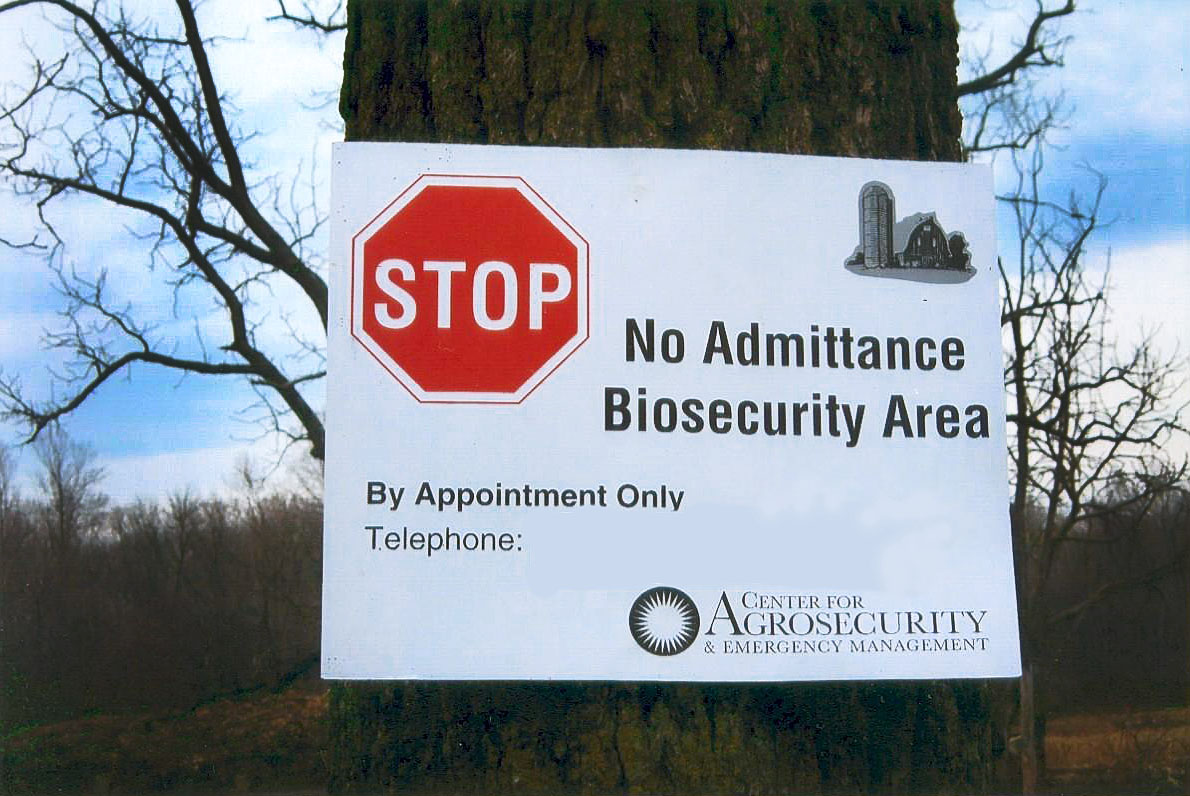 Limit access to your birds.
Limit access to your birds. - Do not permit people with other birds to come in contact with yours.
- Provide clean clothes and footwear for authorized or essential visitors (such as repairmen) if they come in contact with your birds.
- Consider posting signs to inform others of biosecurity and disease prevention.
- Pave roads or line with gravel to prevent mud accumulation on tires which may carry disease.
- Clean vehicle tires before and after a visit every time a vehicle goes on site.
- Photo credit of "No Admittance Biosecurity Area" image on the right: Dr. Jennifer Timmons
Business

- Avoid sharing animals or equipment with other backyard flock owners.
- Decrease potential disease exposure by conducting business by telephone when possible.
- Clean and disinfect your shoes and clothing after you visit bird exhibits, auctions, or other locations and before you go near your birds.
- Photo on the right was obtained from FEMA website and taken by John Ficara.
Keep It Clean
Sanitation and decontamination, when properly done, can effectively kill pathogens such as avian influenza virus. It only takes 1 gram of AI-contaminated manure to infect one million birds. These procedures are critical to preventing and containing the disease!12,13 Sanitation is a means of promoting health by preventing contact with wastes. Decontamination is a two-part process involving cleaning and disinfecting in order to reduce or remove pathogens. |
 ARS: Stephen Ausmus
|
Sanitation I: Waste Management
Waste management and handling procedures are key to good sanitation. You will preserve litter nutrients, avoid groundwater contamination, prevent disease transmission, and eliminate odors by using these methods. Check with your local Department of Environment
or Natural Resources Conservation Service for approved waste disposal options.
Handling Materials
- Do not use your bare hands when handling waste materials; always wear gloves.
- Prevent direct contact by using tools such as shovels, pitchforks and wheelbarrows.
- Always wash your hands after handling waste materials; never rub your eyes, eat, drink, or smoke if you have dirty gloves on or have not washed your hands with soap and water.
Manure Disposal
- Promptly remove and dispose of manure before adding new flocks. This will help deter pests.
- Do not use raw manure as a fertilizer for gardens as there may be diseases present. It may also kill your plants from excessive nitrogen levels.14
- Composting is the best way to dispose of manure, which may then be used as fertilizer on gardens. For more information on composting visit eXtension's Soil and Composting.
Howdiniguru - How to Make Compost
Sanitation II: Carcass Disposal
Carcass Disposal
From time to time you may have to dispose of animals that have died from old age, injury, stress or disease. Proper disposal will help prevent the attraction of pests and disease.
Dead vermin or wild birds will need to be removed from the premise and disposed of properly away from your flocks. Using gloves, place the animal in plastic bag and seal it. The body may be buried or placed in the trash. Wash your hands when finished. If you see multiple dead wild birds in a short period of time contact the USDA Wildlife Services at 1-877-463-6497.16
Dead poultry may be disposed of by burying, composting, rendering, or incineration in commercial operations. However, in a backyard setting where mortalities are rare, burial is the most useful option. Remember to check with your county first for approved disposal methods.3,9
For more information on these disposal methods visit the University of Maine Cooperative Extension Bulletin #12 https://extension.umaine.edu/publications/12e/ or CAST Science.
Decontamination
Decontamination is a two-part process that reduces or removes pathogens.8
|
 USDA APHIS
|
Avian Influenza Disinfectants
You can usually purchase these disinfectants at most hardware, farm depot, or grocery stores. Do not use disinfectants on living things.
- EPA approved disinfectants such as One Stroke Environ® and Tek-trol®.
- Bleach* - mix ¾ cup of bleach per gallon of water or 1 part bleach to 10 parts water.
- Quaternary Ammonium Compounds* such as Lysol No Rinse Sanitizer®
When to Clean and Disinfect Equipment
|
 Photo Credit: Jenny Madsen
|
Equipment Decontamination Steps
|
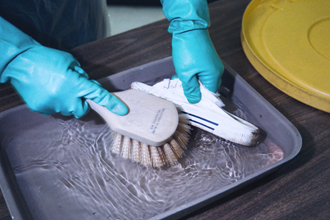 USDA APHIS
|
Poultry Housing
(Clean as needed)
|
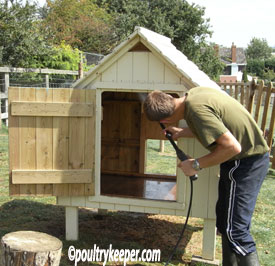 |
Sanitizing Poultry Drinking Water
If you use ponds, streams, or wells as your source of drinking water for your poultry, you should consider adding a sanitizer such as chlorine to the water. This will reduce the level of harmful organisms and other infectious agents in the water and prevent the buildup of slime in your waterers.
- Bleach may be used to sanitize water by adding 1 oz of bleach to 1 gallon of water.
- If giving a vaccine through the drinking water, stop using bleach to sanitize drinking water 2 days prior to vaccination as bleach will inactivate the vaccine and make it ineffective.
- Clean waterers and replenish with fresh water daily.
Vaccination
| Currently, there are two main types of poultry vaccines for avian influenza. However, since avian influenza is not commonly found in the U.S. and vaccination is not 100% effective, AI vaccination is generally not recommended. Practicing good biosecurity is your best approach to preventing avian influenza along with other prevalent diseases. The USDA Animal and Plant Health Inspection Service (APHIS) has made the decision to not use any existing poultry vaccines to fight the current 2014-2015 AI outbreak. For more information on the USDA's decision, visit Highly Pathogenic Avian Influenza and Vaccine Use. For additional tips on vaccination, visit Vaccination and Medication Programs for Small Poultry Flocks |
 CDC Photo Library: Jim Gathany
|
Registration
Click here to find your state's Department of Agriculture site.
Exhibits, Fairs, and Shows
With an increased potential for disease transmission when large numbers of animals gather for exhibition, state departments of agriculture have established requirements for exhibitors.
Below is an example of Maryland's regulations for fairs and shows.20
It is recommended that show birds be kept in isolation
for at least 2-3 weeks after attending fairs or shows.
Requirements for Sponsors of a Livestock/Poultry Exhibition
- Notification shall be made to the Maryland Department of Agriculture (MDA), Animal Health Section of intent to sponsor an event that includes the exhibition of animals at least 60 days before the proposed event. (Notification Form for Livestock/Poultry Exhibition)
- Sponsor shall submit the Notification Form for Livestock/Poultry Exhibition no later than 60 days from the scheduled event to your Regional Health Office.
- Report to the Department any animal from the exhibition suspected of having or showing obvious, apparent, or known signs of a contagious or infectious disease; or exclude from the exhibition premises any animal having obvious, apparent, or known signs of a contagious or infectious disease.
- Exemptions of this regulation may be granted if:
- The exhibition is a Maryland fair and show board funded event; or
- The exhibition is sponsored, sanctioned, or otherwise approved by an association, coalition, or other entity which serves as an umbrella organization for multiple livestock exhibitions in a calendar year and
- That organization provides adequate and timely notice of subordinate exhibitions to the Department.
Requirements for Exhibitors
- All poultry exhibitors must have valid proof of a registered Maryland Poultry Premises ID Number.
- All poultry for exhibition shall meet the requirements for Avian Influenza and Pullorum-Typhoid tests.
- All poultry exhibitors shall complete a Poultry Exhibitor’s Self Certification of Animal Health.
Surveillance and Monitoring
Personal Surveillance and Monitoring10
- Inactivity, ruffled feathers, poor appetite, diarrhea.
- Decreased egg production, soft shells or misshapen eggs.
- Swelling of the head, eyelids, comb, wattles and hocks.
- Cyanosis (dark blue color), sneezing, or nasal discharge.
- Sudden death.
- Inspect your flocks daily.
- Wear gloves when handling a sick bird. The bird should be placed in isolation for 30 days.
- Contact your vet if your birds have serious signs of disease.
- Know the signs of AI.
Global Surveillance and Monitoring
- USDA conducts avian influenza surveillance programs including the National Poultry Improvement Plan (NPIP) and the Smuggling Interdiction and Trade Compliance (SITC).
- The National Center of Import Export (NCIE) requires all imported live birds, except from Canada, to undergo a minimum 30 day quarantine period where they are tested for avian influenza before entering the country.
- Poultry and eggs from countries with HPAI H5N1 are not imported into the U.S.
|
NWHC AI Google Earth Map |
Keeping Your Birds Healthy Video from the USDA
